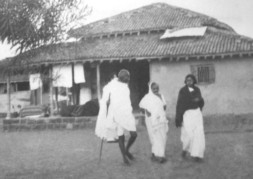
1. Gandhi’s ashrams
Visit Gandhi Ashram in Ahmedabad where you can still feel the energy of Mahatma Gandhi’s freedom movement. Ahmedabad in Gujarat was the centre of Gandhi’s non-violent struggle for India’s independence for many years. On his return from South Africa, Gandhi established his first ashram in India in the Kochrab in 1915. In 1917 the ashram was shifted to the banks of the river Sabarmati and was called Sabarmati or Gandhi Ashram. The ashram was abuzz with khadi, not only as a way of producing clothes but also as a way of thought. Later he moved to Sevagram Ashram near Wardha, Maharashtra, after the Namak Satyagraha, leaving the ashram in the hands of the Harijan Sevak Sangh. Gandhi Ashram, which was home to Gandhi from 1917 until 1930, served as one of the main centres of the Indian freedom struggle. The ashram now functions as a museum and an institution whose aim is to preserve and propagate the legacy of the Mahatma.
2. Ancient Pataliputra
Though many consider Bihar as a failed state today, it was once a centre of power, learning and culture and witnessed the golden period in the country’s history. The first experiments both in the imperial and democratic forms of governance were initiated in this ancient land of Buddha in the 6th century BC. The first experiments both in the imperial and democratic forms of governance were initiated in Bihar in the 6th century BC. The kingdoms of Magadha and Licchavis in ancient Bihar, around about 7-8th century BC, produced rulers who devised a system of administration that truly is progenitor of the modern art of statesmanship and its linkage with economics.
Under the Maurya and Gupta dynasties, the Magadha Empire unified large parts of South Asia under a central rule. Its capital Pataliputra (now known as Patna) was an important centre of Indian civilisation. The centre of higher learning Nalanda, founded in the 5th century by the Gupta rulers, is considered among the oldest and truly international universities. It continued as a seat of learning till the Middle Ages, when the foreign invaders burned it down. The ruins are a protected monument and a popular tourist spot.
3. Ajanta and Ellora Caves
Visit the rock-cut caves of Ajanta and Ellora to witness the degree of skill and artistry that Indian craftsmen had achieved several hundred years ago!
Located in the Aurangabad district of Maharashtra, the Ajanta caves are rich in paintings and sculpture whereas the Ellora caves are renowned for their extraordinary architecture. The most incredible thing about these caves is that they were crafted by hand, with only a hammer and chisel.
Ajanta caves, situated about 107km north of Aurangabad, were discovered in 1819. Ajanta’s 30 caves date back to between the 2nd century BC and 6th century AD, the earliest among them being Cave 10 dating from the 2nd century BC. These caves depict the story of Buddhism, spanning the period from 200BC to 650AD. Ajanta’s paintings and sculptures, considered masterpieces of Buddhist religious art, have had a considerable artistic influence.
The Ellora caves, located at a distance of 30km north of Aurangabad, represent one of the largest rock-hewn monastic-temple complexes in the world. Dating from between the 6th and 11th centuries AD, the 34 caves contain Buddhist Chaityas or halls of worship, and Viharas, or monasteries, Hindu and Jain temples. Unlike Ajanta, the Ellora caves have a distinction that they were never lost to oblivion, due to their close proximity to the trade route. There have been numerous written records indicating that these caves were visited regularly by interested travellers as well as royal personages.
4. Falaknuma Palace
Check in to the Taj Falaknuma Palace in Hyderabad, Andhra Pradesh, and retrace the steps of the Nizams who ruled Hyderabad State since 1724 and who were among the richest men in the world. Falaknuma Palace, the former residence of the Nizam, was leased by the royal family in 2000 to the Taj Hotels Resorts and Palaces. The palace opened as a luxury hotel in 2010.
5. Rock shelters of Bhimbetka
Located in the Raisen district of Madhya Pradesh, 45km south of Bhopal at the southern edge of Vindhyachal mountain range, the prehistoric rock shelters of Bhimbetka exhibit the earliest traces of human life in India. Spread over 10km in length and about 3km in width, the site has more than 700 rock shelters of which more than 400 have paintings.
There are five clusters of natural rock shelters, displaying paintings dating from the Mesolithic Period right through to the historical period. The continuity of human evolution from the Lower Palaeolithic Period is noticed by the smaller size of stone tools in the following Middle Palaeolithic Period besides new tools like scrapers. During the Upper Palaeolithic Period newer tool types had also emerged. However there is a clear change in the materials and tool typology in the Mesolithic Period.
Despite small stupas and other structures found here, it is the rock paintings that attract visitors to Bhimbetka. Inscribed on Unesco World Heritage list in 2003.


